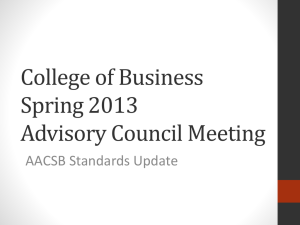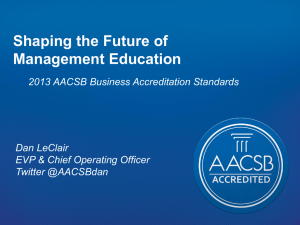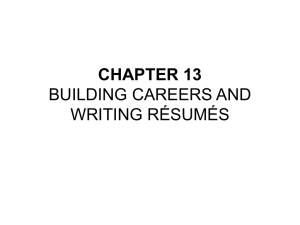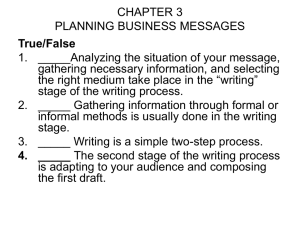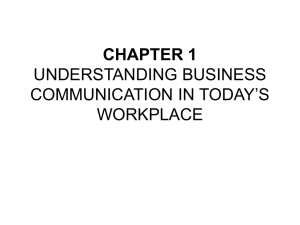CHAPTER 8 WRITING NEGATIVE MESSAGES
advertisement
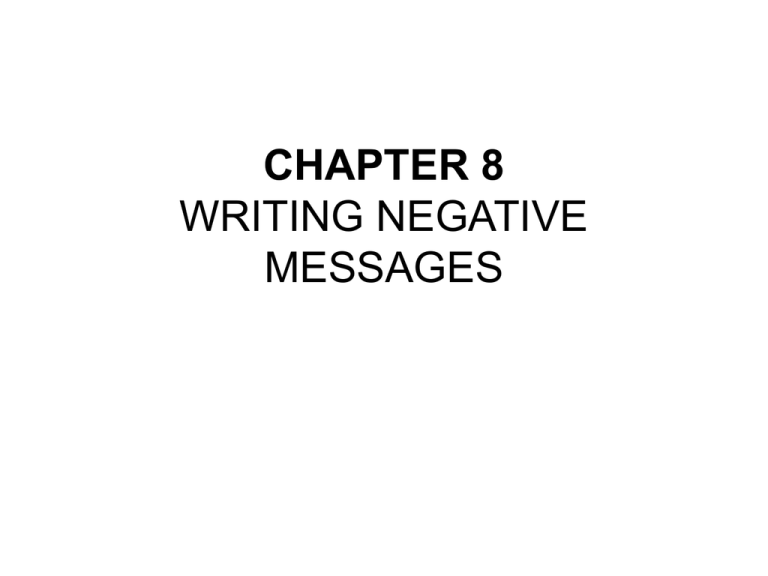
CHAPTER 8 WRITING NEGATIVE MESSAGES • Multiple Choice 1. If you have to say no, you should always a. try to gain the audience’s acceptance of your decision. b.deliver it directly. c. pull back from communicating. d.all of the above 2. When planning your negative message, you should a. gather the information your audience will need to understand and accept your message. b.select your medium carefully. c. acknowledge the probability of a negative audience reaction. d.all of the above. • Multiple Choice 1. If you have to say no, you should always a. b. c. d. try to gain the audience’s acceptance of your decision. deliver it directly. pull back from communicating. all of the above • ANSWER: a. This is an important goal in negative messages. • DIFFICULTY: moderate; PAGE: 172; OBJECTIVE: 1; TYPE: concept; AACSB: Communication 1. When planning your negative message, you should a. gather the information your audience will need to understand and accept your message. b. select your medium carefully. c. acknowledge the probability of a negative audience reaction. d. all of the above. • ANSWER: d. When planning your message carefully analyze the situation; determine how to best approach your audience. How will the audience be likely to respond? • DIFFICULTY: moderate; PAGE: 172; OBJECTIVE: 1; TYPE: concept; AACSB: Communication 1. When delivering bad news, you want to accomplish all of the following goals except a. to convey the bad news. b. to encourage questions and correspondence from the reader. c. to gain acceptance for the bad news. d. to maintain a good image for your organization. 2. When conveying negative news it is important to always a. b. c. d. maintain goodwill with your audience. use an indirect approach. convey the bad news directly. avoid acknowledging any emotional issues. 1. When delivering bad news, you want to accomplish all of the following goals except a. b. c. d. • • 1. ANSWER: b. You want to reduce or eliminate the need for further correspondence on the matter. DIFFICULTY: moderate; PAGE: 172; OBJECTIVE: 1; TYPE: concept; AACSB: Communication When conveying negative news it is important to always a. b. c. d. • • to convey the bad news. to encourage questions and correspondence from the reader. to gain acceptance for the bad news. to maintain a good image for your organization. maintain goodwill with your audience. use an indirect approach. convey the bad news directly. avoid acknowledging any emotional issues. ANSWER: a. Your tone helps your readers accept that your bad news represents a firm and fair decision. It also helps the readers preserve their pride. DIFFICULTY: moderate; PAGE: 173; OBJECTIVE: 1; TYPE: concept; AACSB: Communication 1. ______ By implying the bad news, you may not actually need to state it. 2. ______ In the close of a bad-news message, you should be realistic and acknowledge the probability of future problems. 3. _______ The close of a negative message should offer to answer additional questions and provide further answers if needed. • • • • • • • • • ______ By implying the bad news, you may not actually need to state it. ANSWER: True. It is vital, however, to make sure your audience understands the entire message—including the bad news. DIFFICULTY: moderate; PAGE: 178; OBJECTIVE: 2; TYPE: concept; AACSB: Communication ______ In the close of a bad-news message, you should be realistic and acknowledge the probability of future problems. ANSWER: False. You should be optimistic; avoid statements such as, “should you have further problems…” DIFFICULTY: moderate; PAGE: 178; OBJECTIVE: 1; TYPE: application; AACSB: Communication _______ The close of a negative message should offer to answer additional questions and provide further answers if needed. ANSWER: False. In most cases you do not want to encourage additional communication. DIFFICULTY: moderate; PAGE: 178; OBJECTIVE: 1; TYPE: concept; AACSB: Communication • Fill-in the Blank 1.In negative messages, it is important to maintain a good ______ for your organization. 2.When a negative message gives the bad news in the opening paragraph, the writer is using the ______ approach. 3.When using the indirect approach to deliver bad news, you should open with a neutral, noncontroversial statement called a(n) ______. • Fill-in the Blank 1. In negative messages, it is important to maintain a good ______ for your organization. • ANSWER: Image • DIFFICULTY: moderate; PAGE: 172; OBJECTIVE: 1; TYPE: concept; AACSB: Communication 1. When a negative message gives the bad news in the opening paragraph, the writer is using the ______ approach. • ANSWER: Direct • DIFFICULTY: moderate; PAGE: 174; OBJECTIVE: 2; TYPE: concept; AACSB: Communication 1. When using the indirect approach to deliver bad news, you should open with a neutral, noncontroversial statement called a(n) ______. • ANSWER: Buffer • DIFFICULTY: moderate; PAGE: 176; OBJECTIVE: 2; TYPE: concept; AACSB: Communication • Short Answer/Essay 1. What are the five main goals when delivering negative news in business? • ANSWER: The goals are: 1) to convey the bad news 2) to gain acceptance for it 3) to maintain as much goodwill as possible with your audience 4) to maintain a good image for your organization 5) if appropriate, to reduce or eliminate the need for future correspondence on the matter. • DIFFICULTY: moderate; PAGES: 172; OBJECTIVE: 1; TYPE: concept; AACSB: Communication 1. What are the three main steps you should take in planning a badnews message? • ANSWER: The steps are: 1) Gather the information your audience will need in order to understand and accept your message, 2) select the appropriate medium to deliver the message, and 3) choose the direct or the indirect approach to organize your message. • DIFFICULTY: moderate; PAGES: 172-173; OBJECTIVE: 1; TYPE: concept; AACSB: Communication • • • • • • • Rewrite the following sentence using more positive words: “We don’t have that color in stock.” ANSWER: (Answers may vary.) We can custom order that color and have it here for you by Friday. DIFFICULTY: difficult; PAGE: 173; OBJECTIVE: 1; TYPE: application; AACSB: Communication, Analytic Skills Rewrite the following phrase using positive words rather than negative ones. “I’m sorry, but we’ll have to turn down your bid.” ANSWER: (Answers may vary.) We’ve accepted another company’s bid. DIFFICULTY: moderate; PAGE: 173; OBJECTIVE: 1; TYPE: application; AACSB: Communication, Analytic Skills • • • List and briefly describe the five guidelines for giving negative performance reviews. ANSWER: 1) Confront the problem right away. Avoiding problems only makes them worse. 2) Plan your message. Be clear about your concerns and include examples of the employee’s specific actions. 3) Deliver the message in private. Don’t send performance reviews via e-mail. 4) Focus on the problem. Don’t attack the employee. Compare employee performance with what’s expected, with company goals, or with job requirements. 5) Ask for a commitment from the employee. Help the employee understand that planning for and making improvements are the employee’s responsibility. Set a schedule for improvement. DIFFICULTY: difficult; PAGES: 184-186; OBJECTIVE: 1; TYPE: concept; AACSB: Communication



